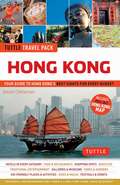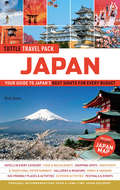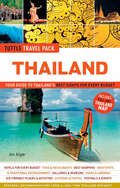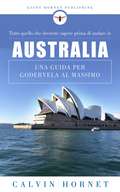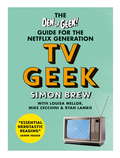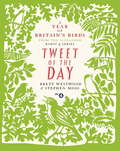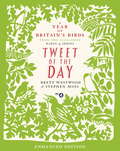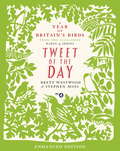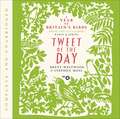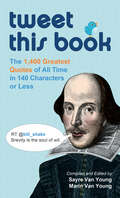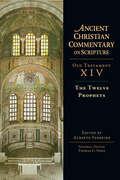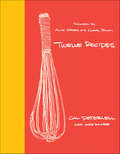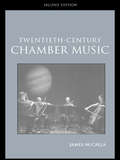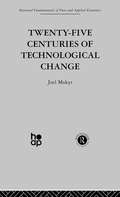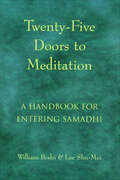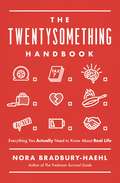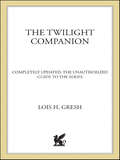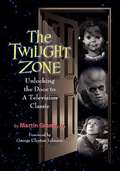- Table View
- List View
Tuttle Travel Pack Hong Kong
by Simon OstheimerAuthor Simon Ostheimer lays out his top picks in three simple chapters: Hong Kong's Best Sights highlights 21 must-see sights and essential experiences: from the world's biggest light and sound show in Victoria Harbor to a traditional fishing village on stilts; and from shopping on Temple Street to the horse races at spectacular Happy Valley or an eco-tour to see the famous pink dolphins. Exploring Hong Kong takes you to top attractions in every part of Central Hong Kong, Hong Kong Island, Kowloon, the New Territories, and the Outer Islands as well as to Macau and the Chinese mainland. Author's Recommendations gives specific details on: excellent hotels and nightspots; the best shopping; the best kid-friendly activities; the best museums and galleries; and the best hikes and nature walks.The author also provides basic travel information, including useful web sites and pointers for getting around Hong Kong. Extensive cross-referencing makes it easy to plan your visit. This guide is extraordinarily useful and well thought-out. It contains a large pullout map at the back plus 24 detailed maps in text. Tuttle Travel Pack Hong Kong is your top pick for an accessible, unforgettable journey.
Tuttle Travel Pack Hong Kong
by Simon OstheimerThe only guide you'll need for getting around Hong Kong! Everything you need is in this one convenient package--including a large pull-out map!Sail bustling Hong Kong harbor in an antique junk, take in the spectacular views from Victoria Peak, and visit the Bruce Lee monument on Hong Kong cinema's very own Walk of Fame. Then ride the cable car up to see the giant Buddha, sample tasty Cantonese dim sum in Causeway Bay, and party the night away in chic, hip Lan Kwai Fong. Hong Kong Tuttle Travel Pack offers you the very best of Hong Kong. This guidebook presents all the top sights and attractions, selected for a wide range of budgets and interests. Easy-to-use and easy-to-carry, it is packed with valuable information, handy lists, maps, photographs, and tips on how to make the most of your stay--so you can spend your time enjoying your visit and not just reading about it. Includes 21 Best Sights, Author's Recommendations, and more!d well thought-out. It contains a large pullout map at the back plus 24 detailed maps in text. Tuttle Travel Pack Hong Kong is your top pick for an accessible, unforgettable journey.
Tuttle Travel Pack Japan
by Rob GossWINNER OF THE 2013 NORTH AMERICAN TRAVEL JOURNALISTS ASSOCIATION GOLD AWARD IN THE TRAVEL BOOK/GUIDE CATEGORYThis is the book that gives you the best of the best! All sights in Japan Tuttle Travel Pack have been hand-picked by seasoned travel writer Rob Goss--who has been living in Japan for over a decade, visiting and writing about every corner of this fascinating country. For this guide we asked Rob to only give us the very best spots--places he goes back to again and again, and where he sends all his friends.This guidebook is lightweight, easy-to-use and jam-packed with information--including maps, photos and tips on making the most of your stay. From the lavish grandeur of a Shogun's memorial shrine to a volcanic hot spring bath and Ryokan to Japan's many UNESCO World Heritage sites like the rock garden at Kyoto's Ryoan-ji Temple--this pocket guide truly offers something for everyone. The range of suggested excursions is exceptional, from hiking up iconic Mt. Fuji to shopping in Tokyo's famous Omotesando fashion district and hitting the slopes at Niseko, home of the world's best champagne powder. The detailed folded map at the back is a huge added bonus!
Tuttle Travel Pack Japan
by Rob GossWINNER OF THE 2013 NORTH AMERICAN TRAVEL JOURNALISTS ASSOCIATION GOLD AWARD IN THE TRAVEL BOOK/GUIDE CATEGORYThis is the book that gives you the best of the best! All sights in Japan Tuttle Travel Pack have been hand-picked by seasoned travel writer Rob Goss-who has been living in Japan for over a decade, visiting and writing about every corner of this fascinating country. For this guide we asked Rob to only give us the very best spots-places he goes back to again and again, and where he sends all his friends.This guidebook is lightweight, easy-to-use and jam-packed with information-including maps, photos and tips on making the most of your stay. From the lavish grandeur of a Shogun's memorial shrine to a volcanic hot spring bath and Ryokan to Japan's many UNESCO World Heritage sites like the rock garden at Kyoto's Ryoan-ji Temple-this pocket guide truly offers something for everyone. The range of suggested excursions is exceptional, from hiking up iconic Mt. Fuji to shopping in Tokyo's famous Omotesando fashion district and hitting the slopes at Niseko, home of the world's best champagne powder. The detailed folded map at the back is a huge added bonus!
Tuttle Travel Pack Thailand
by Jim AlgieThe only guide you'll need for getting around Thailand! Everything you need is in this one convenient package--including a large pull-out map!Explore the regal grandeur of Bangkok's Grand Palace, glide through the city's busy canals on a long-tail boat tour, and bask in the tropical splendor of Phuket's Mai Khao Bay. Visit a temple on holy Mt. Doi Suthep, then take an elephant ride at the Elephant Conservation Center in Lampang. Thailand Tuttle Travel Pack offers you all these experiences and more. This guidebook features only the best sights and activities that Thailand has to offer, chosen for a wide range of budgets and interests by a longtime Thailand resident. Easy-to-use and easy-to-carry, it is packed with information, handy lists, maps, photographs, and suggestions for how to make the most of your stay--so you can spend all your time enjoying your visit. Includes 21 Best Sights, Author's Recommendations, and more!
Tuttle Travel Pack Thailand
by Jim AlgieExplore the regal grandeur of Bangkok's Grand Palace, glide through the city's busy canals on a long-tail boat tour, and bask in the tropical splendor of Phuket's Mai Khao Bay. Visit a temple on holy Mt. Doi Suthep, then take an elephant ride at the Elephant Conservation Center in Lampang. Tuttle Travel Pack Thailand offers you all these experiences and more. It features only the best sights and activities that Thailand has to offer, chosen for a wide range of budgets and interests by a longtime Thailand resident. Easy-to-use and easy-to-carry, it is packed with information, handy lists, maps, photographs, and suggestions for how to make the most of your stay-so you can spend all your time enjoying your visit.
Tuttle Travel Pack Thailand
by Jim AlgieThe only guide you'll need for getting around Thailand! Everything you need is in this one convenient package--including a large pull-out map!Explore the regal grandeur of Bangkok's Grand Palace, glide through the city's busy canals on a long-tail boat tour, and bask in the tropical splendor of Phuket's Mai Khao Bay. Visit a temple on holy Mt. Doi Suthep, then take an elephant ride at the Elephant Conservation Center in Lampang. Thailand Tuttle Travel Pack offers you all these experiences and more. This guidebook features only the best sights and activities that Thailand has to offer, chosen for a wide range of budgets and interests by a longtime Thailand resident. Easy-to-use and easy-to-carry, it is packed with information, handy lists, maps, photographs, and suggestions for how to make the most of your stay--so you can spend all your time enjoying your visit. Includes 21 Best Sights, Author's Recommendations, and more!
Tutto quello che dovreste sapere prima di andare in Australia: Una guida per godervela al massimo
by Calvin HornetQuesta guida riporta tutte le informazioni essenziali per pianificare e realizzare un viaggio in Australia, perché una volta fatto il programma sarà l’isola a fare il resto. Lanciamoci quindi in una nazione di superlativi, in un ipnotico confondersi di evasione e avventura. Qualcuno dice che l’Australia è un luogo dove si va per trovare sé stessi. Noi preferiamo pensarla come un luogo dove ci si perde, tra i territori e le esperienze migliori del pianeta.
TV Geek: The Den of Geek Guide for the Netflix Generation
by Simon BrewEssential nerdtastic reading! - Jason IssacsFrom the author of Den of Geek, this is the ultimate, nerdy television guide for TV geeks everywhere!TV Geek recounts the fascinating stories of cult-classic series, reveals the nerdy Easter eggs hidden in TV show sets, and demonstrates the awe-inspiring power of fandom, which has even been known to raise TV series from the dead. Includes:- How the live-action Star Wars TV show fell apart- The logistics and history of the crossover episode- The underrated geeky TV shows of the 1980s- The hidden details of Game of Thrones- Five Scandinavian crime thrillers that became binge hits - The Walking Dead, and the power of fandomTV series are now as big as Hollywood movies with their big budgets, massive stars, and ever-growing audience figures! TV Geek provides an insightful look at the fascinating history, facts and anecdotes behind the greatest (and not-so-great) shows.
TV Geek: The Den of Geek Guide for the Netflix Generation
by Simon BrewTV Geek recounts the fascinating stories of cult-classic series, reveals the nerdy Easter eggs hidden in TV show sets, and demonstrates the awe-inspiring power of fandom, which has even been known to raise TV series from the dead. Subjects include:- How the live-action Star Wars TV show fell apart- The logistics and history of the crossover episode- The underrated geeky TV shows of the 1980s- The hidden details of Game of Thrones- Five Scandinavian crime thrillers that became binge hits - The Walking Dead, and the power of fandomTV series now have the same budgets, stars, audience figures and cultural impact as Hollywood movies, and TV Geek provides an insightful look at the fascinating history, facts and anecdotes behind the greatest (and not-so-great) shows.This is the ultimate, nerdy television guide for TV geeks everywhere.
Tweet of the Day: A Year of Britain's Birds from the Acclaimed Radio 4 Series
by Stephen Moss Brett WestwoodImagine a jazz musician, improvising on a theme. Then imagine that he is able to play half a dozen instruments - not one after another, but almost simultaneously, switching effortlessly between instruments and musical styles with hardly a pause for breath. If you can countenance that, you are halfway towards appreciating the extraordinary song of the nightingale . . .Wherever we are, there are birds. And wherever there are birds, there is birdsong. It's always a pleasure (and a relief) to hear sounds which prove the world's still spinning: whether it's the sighing of migrating redwings on a damp October night, the twitter of swallows fresh in from South Africa in April or the call of the cuckoo in May. Based on the scripts of BBC Radio 4's beloved year-long series, and distilling two lifetimes' knowledge, insight and enthusiasm into these pages, Brett Westwood and Stephen Moss take you month by month through the year, and the changing lives of our favourite birds. From peregrines swapping sea-cliffs for skyscrapers to swifts spending almost their entire lives on the wing; from charms of goldfinches to murmurations of starlings; from ptarmigans thriving in the Highland snow to the bright green parakeets thronging London's parks; this book is packed full of extraordinary insights and memorable facts. Tweet of the Day is a book for everyone who loves Britain's birds.(Illustrations © Carry Akroyd)
Tweet of the Day: A Year of Britain's Birds from the Acclaimed Radio 4 Series
by Brett Westwood Stephen MossImagine a jazz musician, improvising on a theme. Then imagine that he is able to play half a dozen instruments - not one after another, but almost simultaneously, switching effortlessly between instruments and musical styles with hardly a pause for breath. If you can countenance that, you are halfway towards appreciating the extraordinary song of the nightingale . . .Wherever we are, there are birds. And wherever there are birds, there is birdsong. It's always a pleasure (and a relief) to hear sounds which prove the world's still spinning: whether it's the sighing of migrating redwings on a damp October night, the twitter of swallows fresh in from South Africa in April or the call of the cuckoo in May. Based on the scripts of BBC Radio 4's beloved year-long series, and distilling two lifetimes' knowledge, insight and enthusiasm into these pages, Brett Westwood and Stephen Moss take you month by month through the year, and the changing lives of our favourite birds. From peregrines swapping sea-cliffs for skyscrapers to swifts spending almost their entire lives on the wing; from charms of goldfinches to murmurations of starlings; from ptarmigans thriving in the Highland snow to the bright green parakeets thronging London's parks; this book is packed full of extraordinary insights and memorable facts. Tweet of the Day is a book for everyone who loves Britain's birds.(Illustrations © Carry Akroyd)
Tweet of the Day: A Year of Britain's Birds from the Acclaimed Radio 4 Series
by Brett Westwood Stephen MossImagine a jazz musician, improvising on a theme. Then imagine that he is able to play half a dozen instruments - not one after another, but almost simultaneously, switching effortlessly between instruments and musical styles with hardly a pause for breath. If you can countenance that, you are halfway towards appreciating the extraordinary song of the nightingale . . .Wherever we are, there are birds. And wherever there are birds, there is birdsong. It's always a pleasure (and a relief) to hear sounds which prove the world's still spinning: whether it's the sighing of migrating redwings on a damp October night, the twitter of swallows fresh in from South Africa in April or the call of the cuckoo in May. Based on the scripts of BBC Radio 4's beloved year-long series, and distilling two lifetimes' knowledge, insight and enthusiasm into these pages, Brett Westwood and Stephen Moss take you month by month through the year, and the changing lives of our favourite birds. From peregrines swapping sea-cliffs for skyscrapers to swifts spending almost their entire lives on the wing; from charms of goldfinches to murmurations of starlings; from ptarmigans thriving in the Highland snow to the bright green parakeets thronging London's parks; this book is packed full of extraordinary insights and memorable facts. Tweet of the Day is a book for everyone who loves Britain's birds.(Illustrations © Carry Akroyd)
Tweet of the Day: A Year of Britain's Birds from the Acclaimed Radio 4 Series
by Brett Westwood Stephen MossImagine a jazz musician, improvising on a theme. Then imagine that he is able to play half a dozen instruments - not one after another, but almost simultaneously, switching effortlessly between instruments and musical styles with hardly a pause for breath. If you can countenance that, you are halfway towards appreciating the extraordinary song of the nightingale . . .Wherever we are, there are birds. And wherever there are birds, there is birdsong. It's always a pleasure (and a relief) to hear sounds which prove the world's still spinning: whether it's the sighing of migrating redwings on a damp October night, the twitter of swallows fresh in from South Africa in April or the call of the cuckoo in May. Based on the scripts of BBC Radio 4's beloved year-long series, and distilling two lifetimes' knowledge, insight and enthusiasm into these pages, Brett Westwood and Stephen Moss take you month by month through the year, and the changing lives of our favourite birds. From peregrines swapping sea-cliffs for skyscrapers to swifts spending almost their entire lives on the wing; from charms of goldfinches to murmurations of starlings; from ptarmigans thriving in the Highland snow to the bright green parakeets thronging London's parks; this book is packed full of extraordinary insights and memorable facts. Tweet of the Day is a book for everyone who loves Britain's birds.(Illustrations © Carry Akroyd)
Tweet of the Day: A Year of Britain's Birds from the Acclaimed Radio 4 Series
by Brett Westwood Stephen MossImagine a jazz musician, improvising on a theme. Then imagine that he is able to play half a dozen instruments - not one after another, but almost simultaneously, switching effortlessly between instruments and musical styles with hardly a pause for breath. If you can countenance that, you are halfway towards appreciating the extraordinary song of the nightingale . . .Wherever we are, there are birds. And wherever there are birds, there is birdsong. It's always a pleasure (and a relief) to hear sounds which prove the world's still spinning: whether it's the sighing of migrating redwings on a damp October night, the twitter of swallows fresh in from South Africa in April or the call of the cuckoo in May. Based on the scripts of BBC Radio 4's beloved year-long series, and distilling two lifetimes' knowledge, insight and enthusiasm into this recording, Brett Westwood and Stephen Moss take you month by month through the year, and the changing lives of our favourite birds. From peregrines swapping sea-cliffs for skyscrapers to swifts spending almost their entire lives on the wing; from charms of goldfinches to murmurations of starlings; from ptarmigans thriving in the Highland snow to the bright green parakeets thronging London's parks; this audiobook is packed full of extraordinary insights and memorable facts.Tweet of the Day is a book for everyone who loves Britain's birds, and this audiobook contains over 150 birdsong recordings to bring them to life.(P)2014 John Murray Press
Tweet This Book: The 1,400 Greatest Quotes of All Time in 140 Characters or Less
by Compiled;edited by Sayre Van Young;Marin Van YoungTweetable-length quotes that are clever, cool, smart, touching, wise, funny, and more from the author of The Unofficial Harry Potter Vocabulary Builder.Brevity may be the soul of wit, but 280 characters is the absolute limit on Twitter! Luckily, Tweet This Book allows you to spice up their microblog with the greatest quotes of all time. Each one is not only brief—it is officially tweetable. The quick, punchy quotes in this wonderfully diverse collection come from all circles and include literary greats; politicians like Abe Lincoln, Winston Churchill, and Barack Obama; and sports figures, musicians, and celebrities like Yogi Berra, Tupac Shakur, and Hunter S. Thompson. With an easy-to-use, A-to-Z organization by topic, you can quickly find the perfect quote for anything you want to tweet about.“You’d be surprised how much it costs to look this cheap.” —Dolly Parton“Why go out for hamburger when you have steak at home?” —Paul Newman“The trouble with the rat race is that even if you win, you’re still a rat.” —Lily Tomlin“Giving birth is like taking your lower lip and forcing it over your head.” —Carol Burnett“The only time to eat diet food is while you’re waiting for the steak to cook.” —Julia Child“Some cause happiness wherever they go; others whenever they go.” —Oscar Wilde“Life is too short to blend in.” —Paris Hilton“Whatever you are, be a good one.” —Abraham Lincoln“Women need a reason to have sex. Men just need a place.” —Billy Crystal“Fasten your seat belts. It’s going to be a bumpy night.” —Bette Davis (in All About Eve)
Twelve Extraordinary Women: How God Shaped Women of the Bible and What He Wants to Do with You
by John MacarthurBible teacher John MacArthur offers lessons learned from the lifes of twelve extraordinary biblical women
The Twelve Prophets (Ancient Christian Commentary on Scripture #14)
by Alberto Ferreiro"And beginning with Moses and all the prophets, [the risen Jesus] interpreted to them in all the scriptures the things concerning himself" (Lk 24:27). The church fathers mined the Old Testament throughout for prophetic utterances regarding the Messiah, but few books yielded as much messianic ore as the Twelve Prophets, sometimes known as the Minor Prophets, not because of their relative importance but because of the relative brevity of their writings. Encouraged by the example of the New Testament writers themselves, the church fathers found numerous parallels between the Gospels and the prophetic books. Among the events foretold, they found not only the flight into Egypt after the nativity, the passion and resurrection of Christ, and the outpuoring of the Spirit at Pentecost, but also Judas's act of betrayal, the earthquake at Jesus' death and the rending of the temple veil. Detail upon detail brimmed with significance for Christian doctrine, including baptism and the Eucharist as well as the relation between the covenants. In this rich and vital resource edited by Alberto Ferreiro you will find excerpts, some translated here into English for the first time, from more than thirty church fathers, ranging in time from Clement of Rome, Justin Martyr and Irenaeus (late first and early second centuries) to Gregory the Great, Braulio of Saragossa and Bede the Venerable (late sixth to early eighth centuries). Geographically the sources range from the great Cappadocians--Basil the Great, Gregory of Nazianzus, Gregory of Nyssa--John Chrysostom, Ephrem the Syrian and Hippolytus in the East to Ambrose, Augustine, Cyprian and Tertullian in the West and Origen, Cyril and Pachomius in Egypt. Here is a treasure trove out of which Christians may bring riches both old and new in their understanding of these ancient texts.
Twelve Recipes
by Cal Peternell“The best beginner’s cookbook of the year, if not the decade. In addition to being warm, funny and smart, Twelve Recipes will actually teach you to cook.” —New York Times Book ReviewInternational Association of Culinary Professionals (IACP) Cookbook Award WinnerWhen his oldest son was leaving for college, Cal Peternell, the chef of San Francisco’s legendary Chez Panisse, realized that, although he regularly made dinners for his family, he’d never taught them the basics of cooking. Based on the life-altering course of instruction he prepared and honed through many phone calls with his son, Twelve Recipes is the ultimate introduction to the kitchen.Twelve Recipes will help home cooks develop a core repertoire of skills and increase their culinary confidence. Peternell tells you what basic ingredients and tools you need for a particular recipe, and then adds variations to expand your understanding. Each tip, instruction, and recipe connects with others to weave into a larger story that illuminates the connection between food and life. A deeply personal book, it was written by the chef alone and it glows with warmth and humor. It’s a book you’re as likely to keep by your bedside as your stovetop. With Peternell as your guide, the journey is pure pleasure and the destination is delicious.Twelve Recipes features gorgeous color photos and inset illustrations by Peternell’s wife and sons (all artists), and forewords by celebrated chef Alice Waters and New York Times columnist and bestselling author Michael Pollan.“Delightful and instructive.” —Library Journal, starred review“[A] smart new cookbook . . . written for new cooks, for uncertain cooks, for good cooks looking for simple inspiration.” —Sam Sifton, New York Times“Encouraging and discursive.” —The Atlantic
Twentieth-Century Chamber Music
by James McCallaFirst Published in 2003. Routledge is an imprint of Taylor & Francis, an informa company.
Twenty-Five Centuries of Technological Change: An Historical Survey
by J. MokyrFirst published in 2001. Routledge is an imprint of Taylor & Francis, an informa company.
Twenty-Five Doors to Meditation: A Handbook for Entering Samadhi
by William Bodri Lee Shu-MeiAn indispensable reference for individuals searching for the meditation technique that is best for them.Twenty-Five Doors to Meditation is the first guide to provide extensive, comprehensive, and detailed information about a variety of meditation methods. Together, William Bodri and Lee Shu-Mei make sense of the seemingly conflicting information that exists today regarding the path to spiritual enlightenment. Each meditation technique is fully described as is the interrelationship between the different paths to enlightenment.The authors show how Buddhist techniques can be explained through Taoist principles, Christian techniques through Hindu principles, and so on. Each meditation technique is designed to help you attain samadhi, the crux of spiritual development. The authors explore the scientific basis behind each technique, developmental stages of accomplishment, and each path’s effectiveness for entering samadhi. Especially useful is an extensive list of recommended references for the further study of individual techniques.
The Twentysomething Handbook: Everything You Actually Need to Know About Real Life
by Nora Bradbury-Haehl&“For an age group overwhelmed with information, Bradbury-Haehl finds a way to make it all manageable.&” --Publisher&’s WeeklyLet&’s face it: adulting isn&’t easy. That&’s why young-adult minister Nora Bradbury-Haehl created this essential guide to help you avoid the mistakes, missteps, and financial failures that took others years to learn. Each chapter includes practical, actionable advice that addresses the full range of life&’s challenges, including how to: make a new city feel like home;find the right job for you—and thrive once you&’ve landed it;ward off loneliness and build meaningful post-grad relationships;set boundaries and live in harmony with your roommates—whether they&’re your peers or parents; andreplace destructive habits with ones that make your life better.Whether you&’re seeking meaning and purpose in your life and career or just feeling stuck and confused about your next steps, within these pages you&’ll find answers to your most pressing questions and advice, encouragement, and inspiration from others who want to help you through these challenging years—together.
The Twilight Companion: The Unauthorized Guide to the Series
by Lois H. GreshEveryone's in love with vampires, and if the vampire's name happens to be Edward Cullen, then readers of the wildly popular Twilight series by Stephenie Meyer can't help but be crazy about him. For all those who adore Bella Swan, Edward, and the rest of the Cullen family and can't get enough, this companion guide is a must. The Twilight series follows an unlikely couple: Bella, a teenager, and her boyfriend, Edward, a vampire who has sworn off human blood. Added to the mix is Jacob Black, a werewolf who also loves Bella. Seductive and compelling, the four-book series has become a worldwide phenomenon. With legends and lore about vampires and werewolves throughout history, insight into the series, quizzes, and heaps of fascinating facts, this companion guide will give millions of readers the information they've been hungering for since book one! As a special bonus, the companion guide helps readers determine if they are compatible with a guy like Edward!
The Twilight Zone: Unlocking the Door to a Television Classic
by Martin GramsVery few television shows withstand the test of time, and Rod Serling's THE TWILIGHT ZONE is one of the notable exceptions. Proven to be an important part of American culture since its debut on CBS in October 1959, many Hollywood producers, screenwriters and directors have been inspired and influenced by this series. Comic books, magazine articles, numerous television revivals, a major motion picture and even modern audio productions have been produced, showcasing the continuing popularity of this television classic. This definitive history presents a portrait of the beloved Rod Serling and his television program, recounting the major changes the show underwent in format and story selection, including censorship battles, production details, and exclusive memories from cast and crew. The complete episode guide recalls all 156 episodes of the series in detail that has never before been accomplished in any publication. This book will make you want to look back at the episodes once again, whether you are a casual fan or serious enthusiast of the series. Unlock the door to a television classic by reading about the in-jokes, bloopers, and other trivia associated with the behind-the-scenes production of . . . THE TWILIGHT ZONE!
